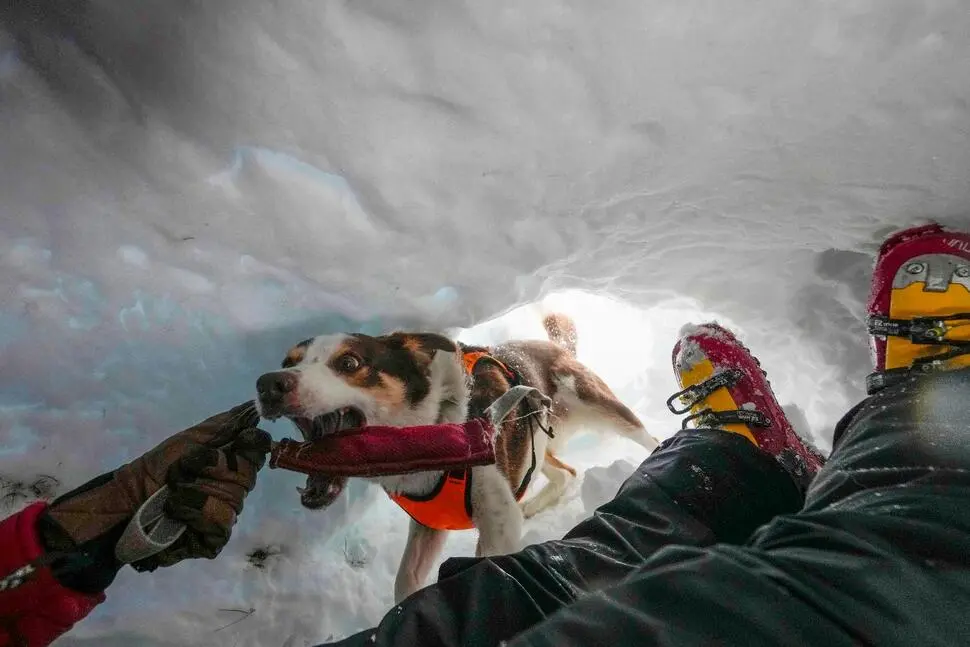The role of dogs in Italian alpine rescues is becoming more important as the number of people caught by avalanches increases — up by 50% over the last 25 years
CORTINA D’AMPEZZO, Italy (AP) — Picture this: Zen, a lively 5-year-old border collie, bounding around a snow mound, his nose twitching in excitement as he picks up a scent. His movements are swift, a signal to his handler that someone lies buried deep beneath the snow.
Zen is no ordinary dog. He’s been a rescue dog for three years, and on this snowy day in the Italian Dolomites, he’s leading the charge, training to set an example for 20 other dogs who are being certified for avalanche rescue. Nestled in this stunning mountain range, famous for inspiring artists, poets, and adventurers, Zen’s role is more critical than ever.
As avalanches in Italy become more frequent — up 50% over the past quarter-century — dogs like Zen are becoming indispensable heroes in the fight for survival. Climate change is playing a pivotal role in this increase, making snow heavier and wetter, especially in mid-altitudes where most outdoor enthusiasts explore. This kind of snow compresses air pockets, making it far harder for someone buried beneath to breathe, reducing their chances of survival.
In these perilous conditions, Zen’s finely tuned nose is more accurate than any high-tech transponder. Adriano Favre, who runs the canine training camp in Cortina D’Ampezzo, explains that a rescue dog’s ability to find buried victims “in the shortest possible time” is critical.
On this particular training day, Zen picks up a scent, and moments later, he emerges triumphantly, clutching a rope tug toy — the “sign of life” he’s trained to retrieve. His handler, Paolo Sbisa, praises Zen as he quickly digs a volunteer “victim” from the snow. This bond between handler and dog is crucial; without it, Sbisa says, “we can’t read what he is trying to tell us.” Once trust is established, Zen is eager to please, performing his life-saving tasks with unwavering dedication.
But sometimes, the stakes are far higher.
Just days earlier, on nearby Giau Pass, Zen was called into action for a real emergency. A deadly avalanche had struck, burying three backcountry skiers under tons of snow. Zen and Sbisa were on the first helicopter out. By the time they arrived, one victim had already been pulled from the snow. A transponder helped locate a second victim, but Zen’s sharp nose was essential in pinpointing the third skier, a woman buried 3 to 4 meters (9 to 12 feet) deep, deeper than usual. Despite their best efforts, both the second and third victims didn’t survive, underscoring a grim reality: Once a rescue dog is called in, it’s often too late to save the person alive.
Zen’s role is irreplaceable, but the sad truth is that rescue dogs, more often than not, help locate bodies, not living victims. This is why backcountry adventurers must be equipped with transponders, probes, and shovels. The best chance of survival comes from self-rescue by companions or witnesses.
“Once something goes wrong, the only weapon Alpine rescuers have is dogs,” says Sbisa. “Without them, we have no other chance.”
Avalanche rescues in Italy have become more frequent, with the number of incidents doubling in the past 25 years. Survival rates depend largely on time — the first 10 to 15 minutes are crucial. After 35 minutes, the chances of survival plummet. This is why rescuers are exploring the idea of having dogs stationed at ski areas to reduce response times, which could be as fast as five minutes.
But climate change is complicating matters further. Heavy, wet snow, once reserved for spring, now arrives as early as December, particularly at mid-altitudes. The more moisture-laden snow compresses air pockets and makes survival after burial even less likely. Additionally, with glaciers shrinking and less overall snow, avalanche deaths due to asphyxiation and trauma are expected to rise.
And then there’s the improbable survivor: Roberto Ferrino, a backcountry skier buried under an avalanche in the Alps seven years ago. Trapped for nearly five hours, Ferrino defied the odds and survived, thanks to a rare air pocket that allowed him to breathe. His body temperature dropped to a near-fatal 26°C (78.8°F), and his heart rate slowed to just 30 beats per minute.
Despite warnings of avalanche risk, Ferrino has no regrets. “If I had done the normal route, nothing would have happened,” he said. A reminder that, even in the face of nature’s fiercest forces, survival is a fragile thing — and sometimes, it’s the bond between a human and a dog that tips the balance.
